博弈论第一章
- 格式:pdf
- 大小:108.85 KB
- 文档页数:13
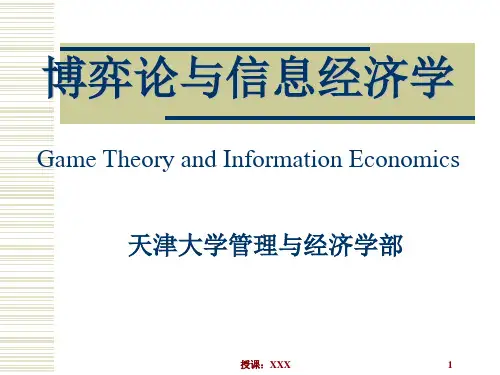
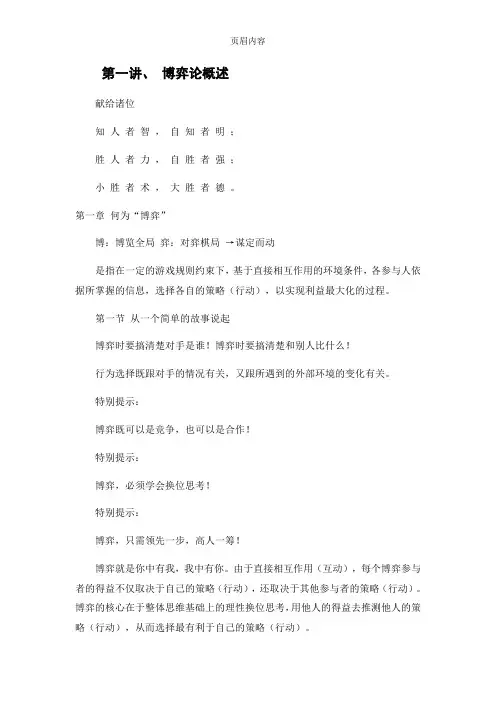
第一讲、博弈论概述献给诸位知人者智,自知者明;胜人者力,自胜者强;小胜者术,大胜者德。
第一章何为“博弈”博:博览全局弈:对弈棋局→谋定而动是指在一定的游戏规则约束下,基于直接相互作用的环境条件,各参与人依据所掌握的信息,选择各自的策略(行动),以实现利益最大化的过程。
第一节从一个简单的故事说起博弈时要搞清楚对手是谁!博弈时要搞清楚和别人比什么!行为选择既跟对手的情况有关,又跟所遇到的外部环境的变化有关。
特别提示:博弈既可以是竞争,也可以是合作!特别提示:博弈,必须学会换位思考!特别提示:博弈,只需领先一步,高人一筹!博弈就是你中有我,我中有你。
由于直接相互作用(互动),每个博弈参与者的得益不仅取决于自己的策略(行动),还取决于其他参与者的策略(行动)。
博弈的核心在于整体思维基础上的理性换位思考,用他人的得益去推测他人的策略(行动),从而选择最有利于自己的策略(行动)。
特别提示:站在别人的立场上想一想,就是为自己未来的遭遇着想。
——米兰·昆德拉特别提示:如果因为对方眼中的你的傻,而让对方更愿意和你合作,何乐而不为呢?(大智若愚)特别提示:请不要在一个充分竞争的市场去追求成功!特别提示:选对市场(对手)比选对策略更重要!特别提示:在博弈之前,博弈就已经开始了!第二节博弈的渊源一、中国的理解博+弈=下围棋略观围棋,法于用兵,怯者无功,贪者先亡。
----汉代刘向,《围棋赋》二、西方的理解game(规则)费厄泼赖(fair play)第三节学习博弈论的收益一、当局者清更有利的选择更快速的反应二、旁观者更清理解历史与现实预测未来的发展三、提出完善游戏规则(制度)的建议第二章发展简史第一节最初的探索和应用一、古诺模型参加博弈的双方以各自在同一时间内相互独立的产量作为决策的变量,是一个产量竞争模型。
二、伯川德模型该模型与古诺模型的不同之处在于,企业把其产品的价格而不是产量作为竞争手段和决策变量,通过制定一个最优的销售价格来实现利润最大化。

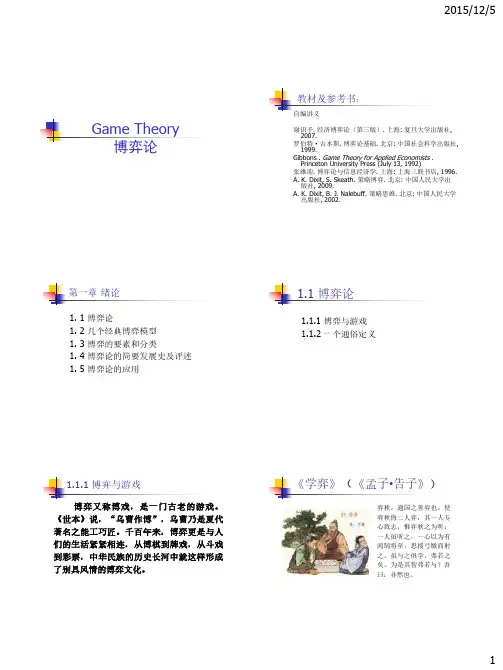
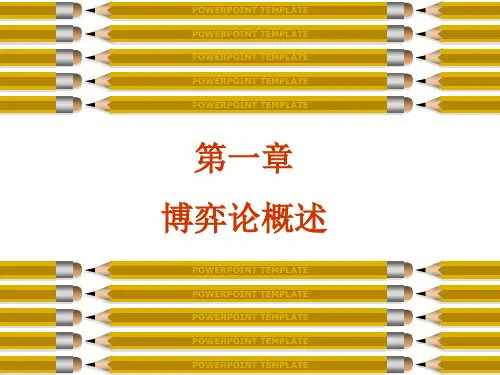
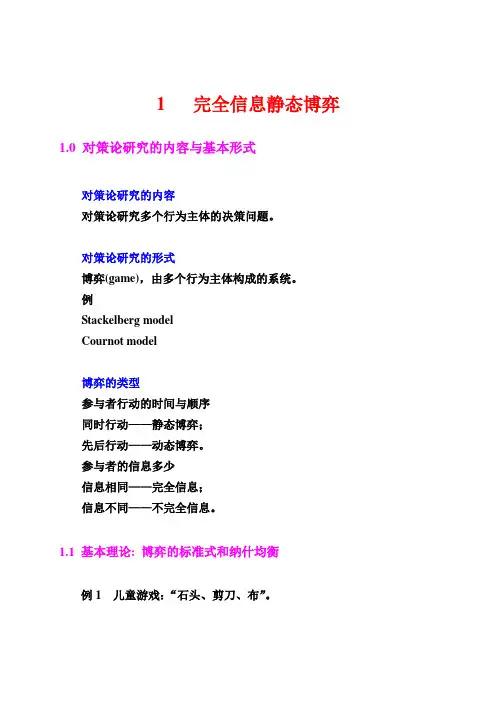
1 完全信息静态博弈1.0 对策论研究的内容与基本形式对策论研究的内容对策论研究多个行为主体的决策问题。
对策论研究的形式博弈(game),由多个行为主体构成的系统。
例Stackelberg modelCournot model博弈的类型参与者行动的时间与顺序同时行动——静态博弈;先后行动——动态博弈。
参与者的信息多少信息相同——完全信息;信息不同——不完全信息。
1.1 基本理论: 博弈的标准式和纳什均衡例1 儿童游戏:“石头、剪刀、布”。
博弈的标准式表示(normal-form representation)(1) 参与人( player).n 个参与人:1, 2, …, i, …, n.(2) 战略(strategy).一个参与人的战略是他采取的一个行动。
参与人i 的战略:s i.参与人i 的战略空间: S i.战略的一个组合: s ={s1,s2, …, s n}.简化表示:s-i ={ s1,…, s i -1,s i+1, …, s n }.(3) 收益(payoff).参与人i 的收益:u i= u i(s1,s2, …, s n)n个参与人博弈的标准形式表示:G = {S1, S2, …, S n;u1, u2, … , u n}完全信息(complete information):每个参与人知道其他人的战略空间和收益。
静态博弈(static game):所有的参与人同时行动。
每个人行动时,不知道其他人的行动。
例1(续):博弈{石头、剪刀、布} 的描述:参与人:1,2。
战略空间:S1 = S2 = {石头、剪刀、布}收益:两人出手的函数u1 (石头,石头) = 0,u1 (石头,剪刀) = 1,u1 (石头,布) = -1 …u2 (石头,石头) = 0,u2 (石头,剪刀) = -1,u2 (石头,布) = 1 ……收益表:两个参与人,有限个战略的博弈的表示方法。
P2石头剪刀布石头0 ,0 1 ,-1 -1 ,1P1剪刀-1 ,1 0 ,0 1 ,-1布 1 ,-1 -1 ,1 0 ,0博弈的问题:能否知道每个参与人选择的战略?例2: 囚徒困境(The Prisoner’s Dilemma)囚徒 2沉默招认沉默-1 ,-1 -9 ,0囚徒 1招认0 ,-9 -6 ,-6囚徒1的考虑:无论对方选沉默还是招认,自己选“招认”好于“沉默”。
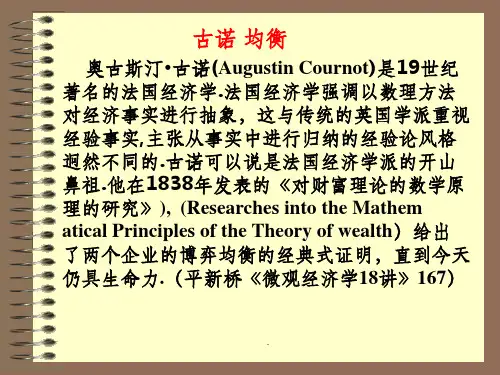



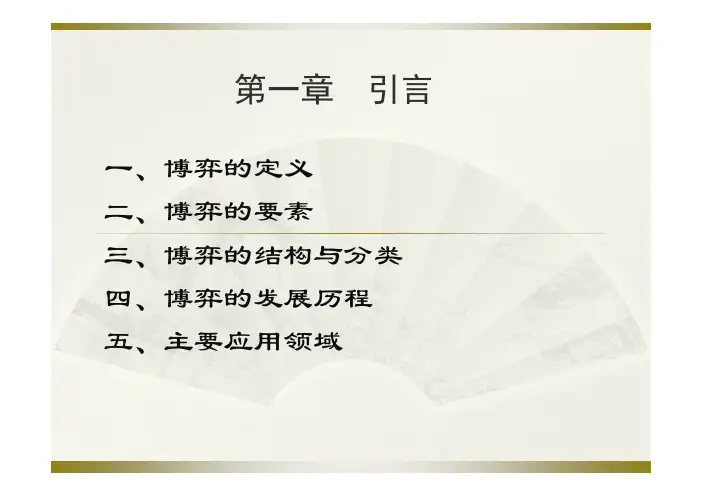
第一章引言一、博弈的定义二、博弈的要素三、博弈的结构与分类四、博弈的发展历程五、主要应用领域一、博弈的定义博弈就是策略对抗,或策略起关键作用的游戏←博弈Game,博弈论Game Theory,Game即游戏、竞技←游戏和竞技等决策竞争较量的共同特征:规则、结果、策略选择,策略和利益相互依存,策略的关键作用游戏——下棋、猜大小经济——寡头产量决策、市场阻入、投标拍卖政治、军事——美国和伊拉克、以色列和巴勒斯坦一、博弈的定义一个非技术性定义定义:博弈就是一些个人、队组或其他组织,面对一定的环境条件,在一定的规则下,同时或先后,一次或多次,从各自允许选择的行为或策略中进行选择并加以实施,各自取得相应结果的过程。
一、博弈的定义1、博弈论是研究决策主体的行为相互作用时的策略以及这种策略均衡问题的理论——张维迎《博弈论与信息经济学》2、博弈论可以定义为对理性决策者之间冲突与合作的数学模型的研究——R.B.Myerson(2007年诺奖得主)《博弈论——矛盾冲突分析》1991年开篇第一句话四个核心方面博弈的参加者(Player)——博弈方各博弈方的策略(Strategies)或行为(Actions)博弈的次序(Order)博弈方的得益(Payoffs)←1、博弈方和局中人:博弈中的决策主体,通过选择行动(或策略)以最大化自己的支付(效用、收益)。
可以是自然人,也可以是团体,比如企业、国家等←2、虚拟参与人(pseudo-player):又称“自然”(nature)指决定外生随机变量的概率分布机制。
比如,市场需求的大小,就业率的高低等等。
←3、策略(战略):相机行动方案(支配参与者在什么时候选择什么行动)。
注:a 战略是行动规则,而不是行动自身;b 静态博弈中,战略等同于行动;c 战略必须是完备的,它要给出参与人在每一种可想象到的情况下的行动选择,即使参与人并不预期这些情况会发生。
←4、支付(收益):参与者策略选择并实施后的结果,是参与人从博弈中获得多少的体现,与策略组合相对应。
博弈论第一章总结那咱就开始唠唠博弈论第一章的那些事儿哈。
博弈论啊,这可是个超级有趣的东西呢。
第一章就像是打开博弈论大门的一把小钥匙,虽然小,但可重要啦。
这第一章啊,主要就是给咱介绍啥是博弈论的基本概念。
就好比是你要去一个新地方,先得知道这个地方是干啥的,大概啥样对吧。
博弈论呢,简单来说就是研究在不同的决策情况下,人们或者各方之间是怎么互相影响的。
比如说啊,下象棋的时候,你走一步,对方走一步,你每一步的决策都要考虑到对方可能会干啥,对方也是一样,这就是一种博弈呀。
这里面有个很重要的点就是参与者。
这些参与者就像一场大戏里的演员,每个参与者都有自己的目标,就像演员都有自己的角色任务一样。
比如说在商业竞争里,那些公司就是参与者,每个公司都想赚更多的钱,扩大自己的市场份额,这就是他们的目标啦。
而且这些参与者的决策可不是瞎做的哦,都是为了达到自己的目标去想办法的。
再说说策略这个事儿。
策略就像是每个参与者手里的武器或者魔法棒。
不同的参与者有不同的策略可以选择。
还拿商业竞争举例哈,如果一家公司想要增加市场份额,它可以选择降低价格,提高产品质量,或者做很多广告这些策略。
而且每个策略都会对其他参与者产生影响呢。
比如说你降价了,别的公司可能就会受到影响,也跟着降价或者想出其他办法来应对。
信息也是博弈论第一章里不能少的部分。
信息就像是在黑暗里的灯光,有多少信息就决定了你能多清楚地看清局势。
要是你知道很多关于其他参与者的信息,比如他们的策略啦,他们的目标啦,那你做决策的时候就更有把握。
但是要是你啥都不知道,就像在黑夜里瞎摸,那可就危险啦。
比如说在谈判的时候,如果一方知道另一方的底线,那这一方就有更大的优势,能更好地争取自己的利益。
这第一章的博弈论啊,其实就是把这些基本的东西一股脑儿地摆在我们面前,让我们对博弈论有个初步的认识。
它告诉我们在各种情况下,人与人、公司与公司、国家与国家之间的互动都是有规律可循的。
就像我们解开一个谜题一样,每一个概念都是一块小拼图,当我们把这些小拼图都搞清楚了,就能慢慢看到整个博弈论这个大拼图的全貌啦。
Kousha Etessami AGTA:Lecture1
Kousha Etessami AGTA:Lecture1
Kousha Etessami AGTA:Lecture1
Kousha Etessami AGTA:Lecture1
is a pair(n-tuple)of strategies for the2players(n players)such that no player can benefit by unilaterally
(i.e.,randomized)Nash equilibrium.•Example1:The pair of dominant strategies (Defect,Defect)is a pure
solution to this zero-sum game.The“minimax value”is0, as it must be because the game is“symmetric”.)•Question:How do we compute a Nash Equilibrium for a given game?
”(also called“normal form
.
What if,as is often the case,the game is played by a sequence of moves over time?(Think,e.g.,Chess.) Consider the following2-person game tree:
•How do we analyze and compute“solutions”to extensive form
Kousha Etessami AGTA:Lecture1
(probabilistic)nodes, controlled by neither player.(Poker,Backgammon.) Also,a player may not be able to distinguish between several of its“positions”or“nodes”,because not all information is available to it.(Think Poker,with opponent’s cards hidden.)Whatever move a player employs at a node must be employed at all nodes in the same“information set
.
Theorem Afinite n-person extensive game of perfect information has an“equilibrium in pure strategies”. Again,how do we compute solutions to such games?
Kousha Etessami AGTA:Lecture1
(think EBay)Think of an auction as a multiplayer game between several bidders.If you are the auctioneer,how could you design the auction rules so that,for every bidder, bidding the maximum that an item is worth to them will be a“dominant strategy”?
One answer:Vickery auctions
Kousha Etessami AGTA:Lecture1
modeling“rational agents”and their interactions.(Similar to Econ.view.)
•Games in Modeling and analysis of reactive systems:
: e.g.,Byzantine agreement.
•Games in Algorithms
:Many computational complexity classes are definable
in terms of games:Alternation,Arthur-Merlin
:GT characterizations of logics,including modal and temporal logics,
and logics that capture computational complexity
classes(Ehrenfeucht-Fraisse games).
•Games in Semantics
:An extremely active research area at the intersection of CS and
Economics.
Basic idea:“The internet is a HUGE experiment
in interaction between agents(both human and
automated)”.
How do we set up the rules of this game to harness
“socially optimal”results?
I hope you are convinced:knowledge of the principles and algorithms of game theory will be useful to you for carrying on future work in many CS diciplines.
Γ,with n players, consists of:
1.A set N={1,...,n}of players.
2.For each i∈N,a set S i of(pure)strategies.
Let S=S1×S2×...×S n be the set of possible combinations of(pure)strategies.
3.For each i∈N,a payoff(utility)function
u i:S→R,describes the payoffu i(s1,...,s n)to player i under each combination of strategies. (Each player prefers to maximize its own payoff.)
Definition A zero-sum
Kousha Etessami AGTA:Lecture1
guess of all players wins a payoffof1.All other players get a payoffof0.(If there are ties for who is closest,all who are closest get payoff1.)
Question:What would your strategy be in such a game?
Question:What is a“Nash Equilibrium”of such a game?。